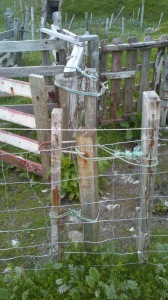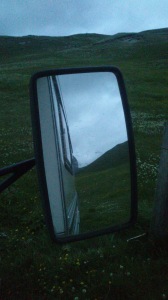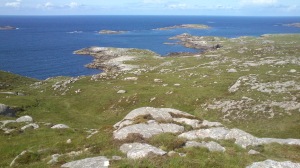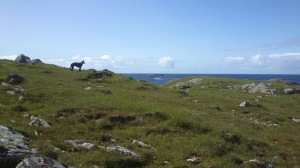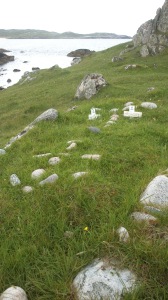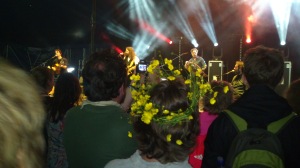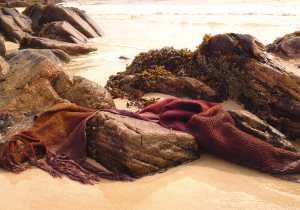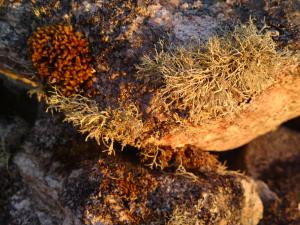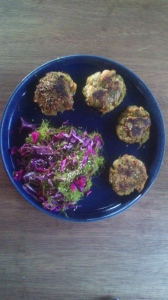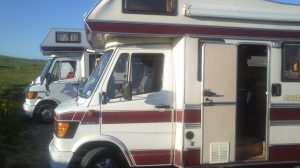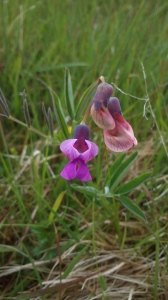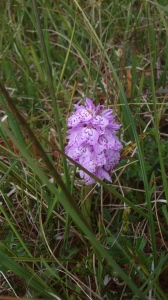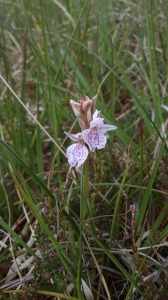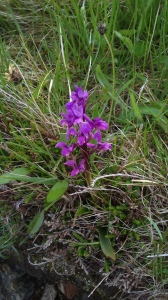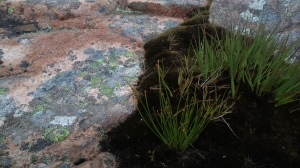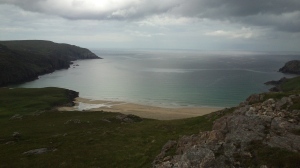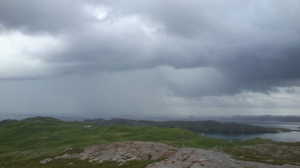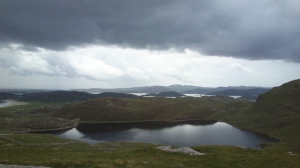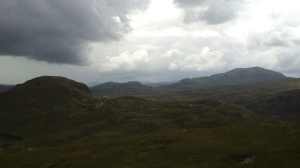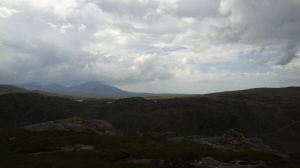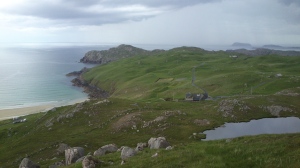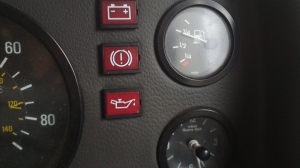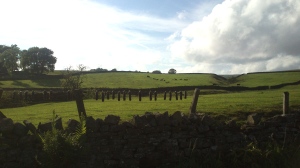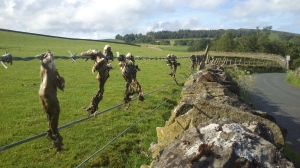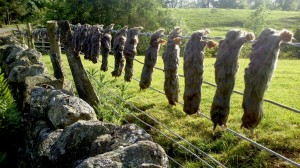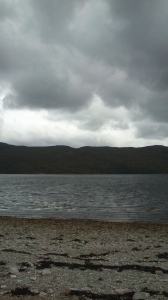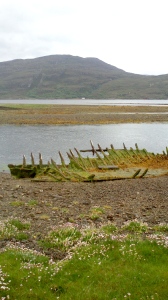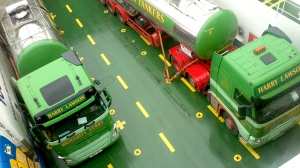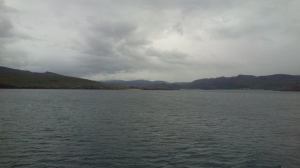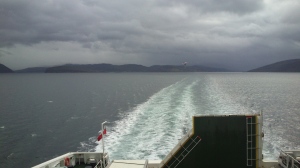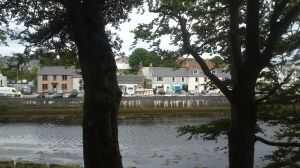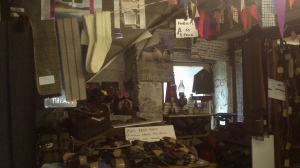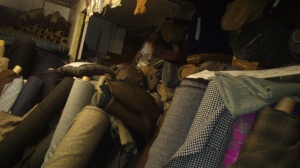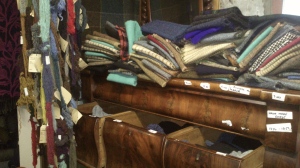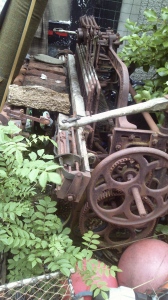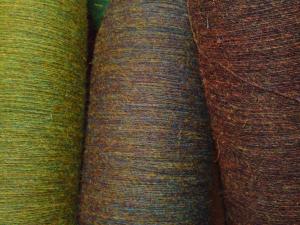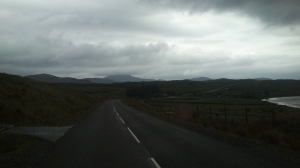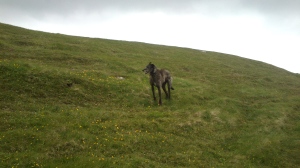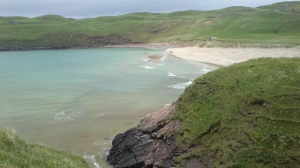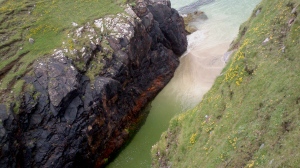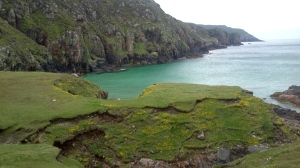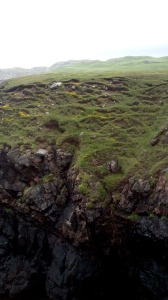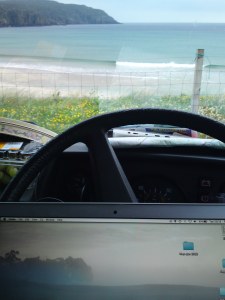A ‘Mevagissy treat’, held my forebears, is a wet arse and no fish. The seventy-something Leòdhasach returned from his long night on the misty moor (Liz Caroll tune) fuming: ‘Never again! The quads and nets have drained the best lochen and it was so cold I didn’t get a wink of sleep. I am too old for this!’ I thought the clear evening and sunny morning beautiful, but I am dismayed. However he says he says this every time, and still does it, so then I am glad. I fear the world would be lacking if he ceased. (For one thing, I was glad that his scooter was parked by my bus overnight when an edgy-looking windsurfer cased my remote joint for a parking spot late last night, and looked at me just too long. Though likely he was more nervous than I was.)
I go into Stornoway for another reality-day, do some PR online, and gladly pick up another commission from another warm, inspired, American creative who knows the Chagfordian fairy-folk of Dartmoor and sends some beautiful pictures as inspiration (Amy, it’s quite surreal, and quite lovely, to be meeting you all over again in another!). I then head back out West. There is a ‘music night’ in the interesting-sounding Loch Chroistean (‘Krishten’?) Centre, but since this turns out to be a fully booked restaurant with a couple of local trad musician serenading the pre-booked diners of whom I am not one, I turn to go again. As I do I am caught by sirens chiming the wind: have you ever heard an orchestra of scaffolding bars singing in a gale? It is astounding. (Amy, did you send me those? Port Na Bucai)
Disappointed that I’m missing out on the (human-made) music front but delighted that I’m bound for my favourite bay after a week away, I get back into the van. I take a little detour though, trying again to identify the converted croft-house rental; this time I spot it as it disappears in my rearview. I pull up above my bay, wondering at the strengthening wind, but deciding to try the high spot anyway, in part for solitude, in part to allow the van already down on the machair to have it to themselves. Mindful of the force whateveritis, I keep back from the first grassy drop, pointing up the hill a little. I walk Murph along the point a short way. It is the kind of wind you can lean into but not breathe into. A young guy in a Land Rover pulls onto the same sheep tracks, and, recognising me from the lock-in in the Royal, reverses up beside me as I get back. It is Calum the local crofting, surfing, guitar-playing geologist (it turns out), checking the 10pm waves but loathe to get into a wet wetsuit. He points out how the clean lines of swell that are spanning the whole bay are taking too long to crest, only breaking in the shallows, flattened by the crosswind. We natter for 20 minutes, strangely softly over the diesel of his engine and the hassle of the wind. He asks questions about my new and former life, interested, and we exchange brief stories, but he has the kind of eyes that never leave the sea.
I’m watching a bird that has been perched on the top of a tump in front of me for half an hour. I am in the eagle’s larder here, but this one’s shoulders are insubstantial, and that tump is too small and close for it to be a bird of her size. No-one is chastising her, but then apparently gazelle know the difference between hungry lion and satiated lion. My beachcombing friends said buzzards were rare here but they’d recently seen one mobbing another, whilst someone else here said there were none, only eagles. I would guess buzzard were I at home on Dartmoor. Maybe hoodie up here. Eventually it rises off the rock: buzzard. So small. Eagles seem in this landscape the size that buzzards are on Dartmoor, and buzzards here are tiny.
I learn what it means to batton down the hatches – though wish I had some battons and some hatches. Calum said a winter gale might take me over the edge, but that this one would be alright, though I could turn my tail into it rather than be broadside on. Keen to just get in out of the wind, I take only the first part of his advice. From the cab seat where I eat my supper, the van seems to move surprisingly little in the buffeting force, and I congratulate it. It’s a heavy old thing, seriously laden. From the bed up top though, the movement is much more, and increases as I lie awake. Everything rattles. The whole thing is only being buffeted though, I tell myself, not rocked. I hit upon a comforting thought, but draw a worrying conclusion, and go round and around the same thought over and over, hoping the conclusion might mutate. When I drive my cowbell swings and rings. If it’s not doing that, that means we’re not moving as much as when we drive, and when we drive, I don’t feel in danger of tipping over. Much. Though it does roll an awful lot. So can we safely tilt as much when stationary as when moving? The conclusion is, again and again: probably not, because when moving we are driving forwards out of the roll, and that’s why we don’t tip. When there’s a little lull, my eyes close and inertia beckons comfortingly. Several times I am jolted out of this, and worry awhile. What if an exceptional summer like this one brought an exceptional gale, like a winter one? In the interests of relaxing somewhat, I swap my feet and head end of the bed, so that if we tip over, I land feet first. Rattle, rock, jolt, roll, rattle. I forget to breathe. Finally aware of this ridiculous resistance to changing one’s situation, I get up, drive off the chocks, reposition, get out into the gale, move the chocks, drive onto them level again, and attempt sleep that way. Rattle, rock, jolt, roll, rattle. I think the wind swings northerly to match. What would it feel like to tip over? Would I be safer on the floor? No, because my furniture is dead heavy and unsecured. Calum said there was a digger at the farm could right me again. Anyway, it won’t happen. Sleeeeeeep… Rattle, rock, jolt, roll, rattle. LIFT. Fuck. I am in the driver’s seat, manoeuvring off the chocks, and driving down to the machair. Phew. The wind feels like nothing when driving along (note to self). It is 7am and I sleep until midday in this safe little bay I know and love. The flowers have all grown inches since I was here a week ago, despite the coldest, wettest summer they all remember, ever.
Next day the sun is shining as if nothing ever happened. Breeze in the night, you say?
Some friendly Glaswegians I met at my last spot invite me round for an excellent risotto. She’s an under-pressure art teacher, head of faculty at a prestigious secondary school, and I love her vehement, non-stop dialect. She offers helpful thoughts about artist residencies on remote isles. He’s a tough-looking electrician on off-shore wind farms, driven mad by the flicker and pulse of them. They are the type who won’t take any shit, but probably do. They are warm, caring and love Murphy. He complains insightfully that tweed needs something new, and they enthuse about my experiments. Their son is a squaddy and when he gets a moment, confides in me about the girl he loves in another regiment who needs space for a while, but whom he’d love to marry. It’s all another lovely encounter. Into the evening I wind another bladderwrack warp.
Next morning I visit the croft house conversion, and neighbour Alistair, a yachtsman, tells me a hundred useful things, especially about inverters for vans and boats. (I need 240V for my steam iron, really.) It has a lot going for it, but I am loving this life in a bus, so we’ll see.
An internet-stop and then I head along the coast, checking out some new lanes as I go. I crane to see St. Kilda from the spots they say you can, but don’t. I walk Murph down to another beach that is supposed to be magnificent, and it is. Though it is empty, my favourite smell, woodsmoke, greets me, where previous visitors have pulled apart their fire but it is still hot. I would love to cook over this fire – it is that kind of evening: work done, Friday night, can of Guinness, and sunny. But that cauliflower needs using, you’ve got to make cauliflower cheese, you’ve just bought all the other ingredients, and it isn’t a fiery sort of meal. But how lovely: not only cooking supper over a fire on a beach, but cooking supper over an inherited fire on a beach. How lovely. I go back to the van and kit up and return. The fire is hottish but smokes and smokes whatever I do. I find some driftwood with some very weirdie beasties on it (anyone?), sadly dried out and shrivelled.
My great, great, great grandfather, skipper of clipper Wytchwater and first importer of Guinness to the UK, toasted.
Aubergine, courgette, tomato, pepper and feta, prepared.
I’m about to put the veg over the embers when Murph jumps at what sounds like a twig snapping beneath someone’s foot just in the hollow of the nearest dune beside us. There is no-one, but there it goes again. More like a little pebble hitting a bigger stone, of which there are a few lying around. I look up, and see a man kneeling up in the short grass on the opposite hillside, facing us fully some 500 yards away, unhidden, and though I can’t see clearly, I suddenly know that we are being shot at. I shield my eyes from the sun and stop and stare at him. It looks as though he does the same, though he is in the shade – binoculars perhaps. I stare hard. He doesn’t move. Then I wave. He doesn’t wave back. I get up and scan the ground for what he might be shooting, but find nothing, and don’t dare look long. After a few seconds, he gets up, gun clearly discernible, and walks back towards the houses over there, disappearing behind a shed, and then reappearing bellying down again to shoot in a different direction. Rabbits, I guess, with an air rifle, I guess, and he knew that he could do us no harm from that distance, I guess – could he? I feel angry and alarmed, but not rattled like an act of hostility would usually rattle me, so maybe it’s ok, but I gather everything up and usher Murph back to the bus quickly enough. Bastard. I drive a good few miles, several villages away, to my eagle flight path, breathe a sigh of relief and cook cauliflower cheese.
I sleep well, apart from a nightmare that comes from godknowswhere in which a man orders a child virgin to rape and slay, to her weeping mother’s acceptance, ‘because it is Allah’s wish’. Today is another blue day and the sea sparkles – perhaps I just needed another reality-check, to reconnect with the big wide world, not get lost in my little idyll. Kill off the innocence. I follow the peat burn up the hill through red sphagnum bogs and orchids too numerous to count. We startle a bird couple who may be grouse – like corncrakes but redder and darker and the male(?) blacker, with a sound like a hen, a duck, a goose and a frog, all at once (anybody?). I turn around and sit on a rock and take in the golden sand and the rocks and the green and all the beautiful blue – and there she is unexpectedly, in four proud bumps on the horizon, St. Kilda.







